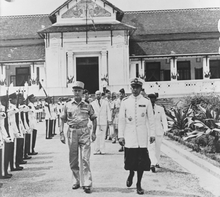Raoul Salan
Raoul Salan | |
|---|---|
| File:Raoul Salan.jpg | |
| Birth name | Raoul Albin Louis Salan |
| Born | 10 June 1899 Roquecourbe, France |
| Died | 3 July 1984 (aged 85) Paris, France |
| Allegiance | |
| Service | French Army |
| Years of service | 1917–1959 |
| Rank | Général d'Armée |
| Commands | 6th Senegalese Tirailleur Regiment 14th Infantry Division French Far East Expeditionary Corps French forces in Algeria |
| Battles / wars | World War I World War II First Indochina War Algerian War Algiers putsch of 1961 |
| Awards | Grand Cross of the Legion of Honor |
| Other work | Leader of the OAS |
Raoul Albin Louis Salan (French pronunciation: [ʁaul salɑ̃]; 10 June 1899 – 3 July 1984) was a French Army general. He served as the fourth French commanding general during the First Indochina War. He was one of four generals who organized the 1961 Algiers Putsch operation. He was the founder of the Organisation de l'armée secrète. He was the most decorated soldier in the French Army.
Early life
Salan was born on 10 June 1899 in Roquecourbe, Tarn.[1] He graduated from the École spéciale militaire de Saint-Cyr.[1] He served in the French Army during World War I.[1]
Military career
Salan served as the commander of French forces in Vietnam from 1945 to 1947.[2] By 1948, he was commander of all French land forces in East Asia; after the death of Jean de Lattre de Tassigny in 1952, Salan became the commander-in-chief in Indochina.[2]

Salan served as commander-in-chief of French forces in French Algeria in 1956.[2] In 1958, Salan called for the return to power of Charles De Gaulle, believing that the latter would protect French Algeria.[2] He retired shortly after, first moving to Spain, then to mainland France.[2] He was banned from entering Algeria in 1960.[2]
Nevertheless, Salan returned to Algeria to organize the putsch on 21 April 1961 with André Zeller, Edmond Jouhaud and Maurice Challe.[2] After the failure of the putsch, he became the chief of Organisation de l'armée secrète (OAS), which attempted to disrupt the April 1962 Peace Evian Accords.[2] He was arrested in April 1962.[2]
Salan was charged with treason[3] and condemned in absentia to death. Then, in April 1962, he was arrested[4] in Algiers. The death sentence on him was commuted to life imprisonment. He was pardoned in 1968.[1]
Salan was the most decorated soldier in the French Army.[2]
Death and legacy
Salan died on 3 July 1984. Every year, former members of the OAS bring flowers to his tomb on his death anniversary.[5]
Decorations
- Légion d'honneur
- Knight (5 April 1922)
- Officer (21 August 1940)
- Commander (10 February 1945)
- Grand Officer (27 October 1948)
- Grand Cross (28 August 1952)
- Médaille militaire (12 July 1958)
- Croix de guerre 1914-1918
- Croix de guerre 1939-1945
- Croix de guerre des Théatres d'Opérations Exterieures
- Croix de la Valeur Militaire
- Médaille Interalliée de la Victoire
- Médaille commémorative de la guerre 1914–1918
- Médaille de l'Aéronautique
- Distinguished Service Cross (US)
- Commander of the Order of the British Empire (CBE) (UK)
Bibliography
- Mémoires Fin d’un empire (4 volumes), Editions Presses de la Cité, 1970–74
- Le sens d’ un engagement, 1970
- Le Viêt-minh mon adversaire, 1971
- Algérie française, 1972
- L'Algérie de Gaulle et moi, 1974
References
- ^ a b c d Krebs, Albin (July 4, 1984). "RAOUL SALAN DIES; LED ALGERIA PLOT". The New York Times. Retrieved June 5, 2016.
- ^ a b c d e f g h i j "Gen. Raoul Salan. France's most decorated soldier dies". Santa Cruz Sentinel. Santa Cruz, California. July 4, 1984. p. 10. Retrieved June 5, 2016 – via Newspapers.com.
{{cite news}}: Unknown parameter|registration=ignored (|url-access=suggested) (help) - ^ Silence in the Dock TIME Magazine Friday, 25 May 1962
- ^ To the guillotine TIME Magazine Friday, 27 Apr 1962
- ^ Cros, Philippe (June 11, 2014). "Les « fidèles » du chef de l'OAS commémorent". La Montagne. Retrieved June 5, 2016.
Further reading
- Alexander, Martin S., and John FV Keiger, eds. France and the Algerian War, 1954-1962: Strategy, Operations and Diplomacy (Routledge, 2013)
- General Paul Aussaresses, The Battle of the Casbah: Terrorism and Counter-Terrorism in Algeria, 1955-1957. (New York: Enigma Books, 2010) ISBN 978-1-929631-30-8.
External links
- Template:Fr icon Association of Friends of Raoul Salan
- Template:Fr icon Raoul Salan, a colonial General by Madeleine Rebérioux
- BBC article on Salan's 1962 sentencing
- 1899 births
- 1984 deaths
- People from Tarn (department)
- French generals
- French military personnel of World War I
- French military personnel of World War II
- French military personnel of the First Indochina War
- French military personnel of the Algerian War
- Members of the Organisation de l'armée secrète
- People sentenced to death in absentia
- Ecole Spéciale Militaire de Saint-Cyr alumni
- Order of the Francisque recipients
- Grand Croix of the Légion d'honneur
- Recipients of the Croix de guerre 1914–1918 (France)
- Recipients of the Croix de guerre 1939–1945 (France)
- Recipients of the Distinguished Service Cross (United States)
- Recipients of the Croix de guerre des théâtres d'opérations extérieures
- Recipients of the Cross for Military Valour
- Recipients of the Aeronautical Medal
- Honorary Commanders of the Order of the British Empire
